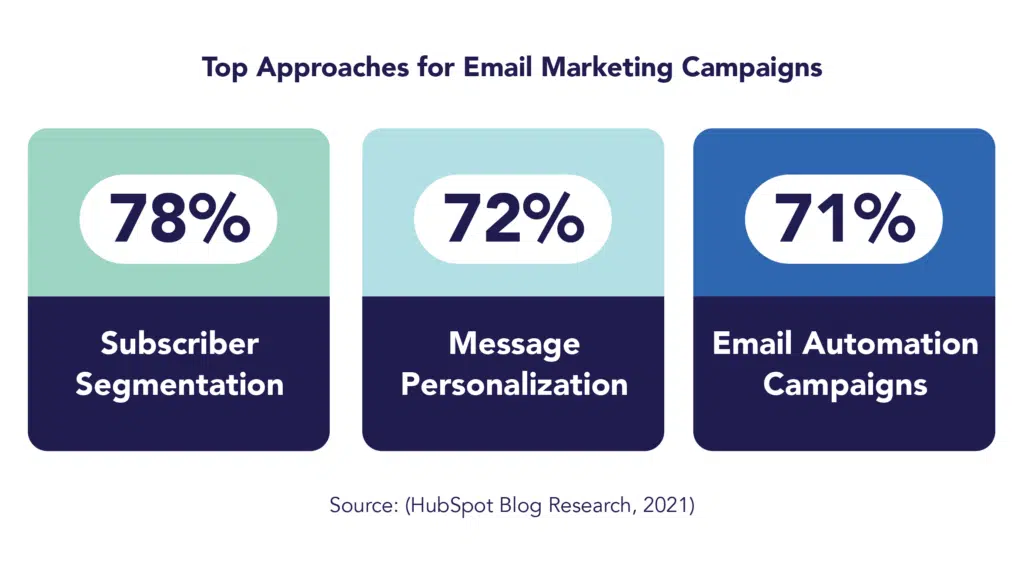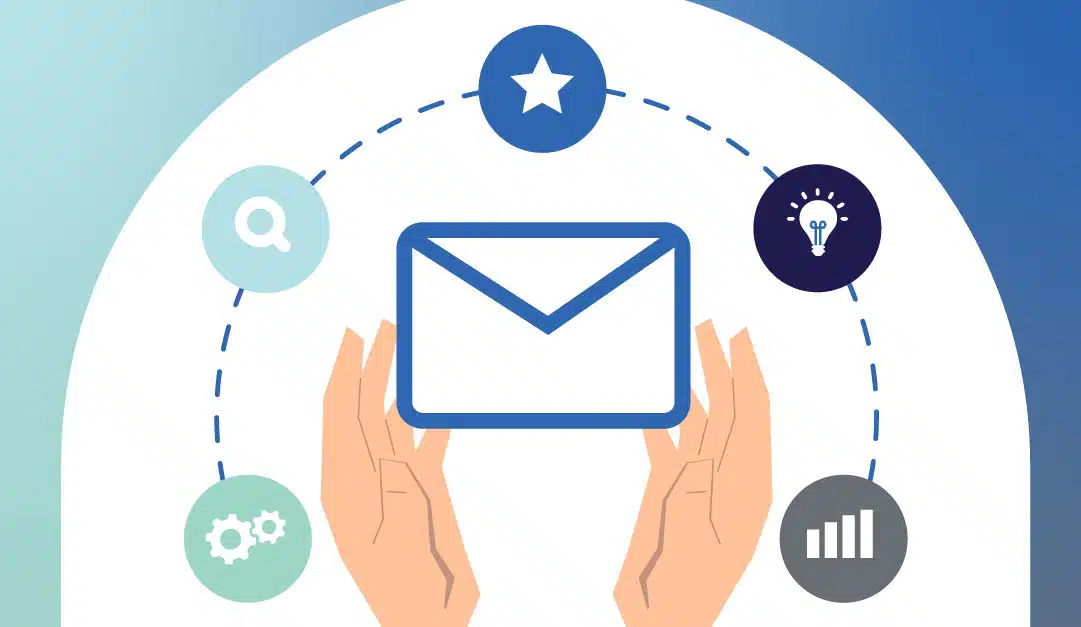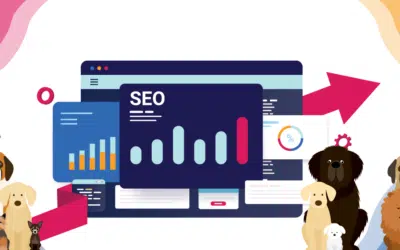Segmentation is a powerful way to target audiences based on their interests and preferences. In email marketing, segmentation lays the foundation for successful campaigns by enabling personalized content and relevant messages that drive engagement. However, effectively reaching the right people at the right time with the right message can be challenging when dealing with a large and diverse audience. That’s why segmentation is a crucial component of any effective marketing strategy. In this blog post, we will explore the importance of segmentation and provide valuable tips on leveraging HubSpot, Klaviyo, and Constant Contact for optimal results.
The Importance of Email Segmentation
Email serves as a powerful tool for comprehending customer behavior and effortlessly connecting with the desired audience through tailored and impactful messages. By segmenting emails, marketers can customize content to engage specific buyer personas and use data-driven insights to shape campaigns. This approach enables companies to have meaningful conversations and establish trust by better understanding customers’ needs. Segmenting email lists also facilitates the delivery of timely messages. By categorizing email contacts into relevant groups, companies can create tailored campaigns that resonate with each segment. This enhances the effectiveness and efficiency of communication and ensures emails are sent when customers are most receptive to taking action. Ultimately, segmentation is key to a successful marketing strategy. It empowers companies to personalize messages and reach the right audience with the right content at the right time, cultivating trust, increasing engagement, and improving ROI. With email segmentation, marketers can elevate campaigns and focus on delivering tailored content that truly resonates with customers.

6 Tips to Maximize Email Segmentation
1. Analyze Your Audience and Choose Appropriate Segmentation Options For Your Emails
Before you start creating contact segments, it’s important to get to know your audience and understand the different characteristics that will help you create effective segments. Analyzing customer data can help you identify commonalities among customers, such as their interests, needs, and preferences. This will enable you to craft emails that are more meaningful and relevant.
Once you have identified key segments within your audience, the next step is to choose the appropriate segmentation options. Some of the most popular segments include geography, demographics, purchase history, and customer preferences. Engagement level is also an extremely important segment, including website engagement, digital advertising engagement, and of course, the level of engagement with past emails. It is important to use these segments in combination with other criteria, such as purchasing intent or lifestyle so that you can build more meaningful relationships with your customers.
2. Get Creative With Personalization Tactics To Better Segment Your Emails
Segmentation is only the first step. Once you have identified the segments, it is important to get creative with your personalization tactics. Personalized emails should be tailored to each segment and offer something of value. There are many ways to customize emails, such as using dynamic content, A/B testing, and automated messages that are triggered by user behavior or events on your website.
A simple example of a personalized tactic that you’ve probably seen many times is an automated email reminding you that you left something in your cart. The emails show the exact item you left behind, encouraging you to complete your purchase. This tactic, however, doesn’t have to be unique to e-commerce B2C companies. With a CRM connected correctly to your website, you can send emails to contacts based on an important page they’ve viewed, serving content relative to that page.
By leveraging personalization tactics, you will be able to create more engaging emails that resonate with customers. Additionally, this approach can help you establish trust and build long-term relationships with your audience.
3. Use Marketing Automation Tools to Streamline the Process of Email Segmentation
Ensuring correct segmentation and personalization is crucial, and automation plays a key role. Automation tools like customer relationship management (CRM) software, marketing automation platforms, and email service providers streamline segment creation, personalized emails, and performance tracking. This allows you to focus on delivering meaningful content instead of manual tasks.
HubSpot, a popular marketing automation platform, offers powerful features for audience segmentation. “Smart lists” enable segmentation based on lifecycle stage, lead status, and custom fields. Leverage this feature to precisely target segments and deliver tailored marketing messages. Develop buyer personas and key demographics for each segment to refine targeting. HubSpot also provides personalization tokens for dynamic insertion of recipient information in emails, enhancing campaign personalization.
Klaviyo, a robust platform, enhances personalization and engagement through advanced segmentation. Integrating seamlessly with platforms like Shopify, Klaviyo effortlessly segments your audience based on behavior, demographics, and engagement levels. Most geared toward B2C companies, Klaviyo can create targeted segments using engagement, purchase history, and demographics to deliver personalized content. Customize emails with dynamic content for tailored messages. Klaviyo’s post-purchase follow-up boosts engagement and retention, providing valuable information, recommendations, and incentives.
Constant Contact streamlines email marketing with advanced segmentation capabilities. Seamlessly segment your audience based on factors like purchase history, location, and engagement. Create personalized segments tailored to specific engagement levels, geographical regions, and behavioral patterns. Enhance email content with Constant Contact’s dynamic content feature for personalized messages. Leverage the autoresponder feature to automatically send customized emails to new subscribers.
By utilizing automation tools, you can optimize segmentation and personalization, allowing you to focus on delivering meaningful content and achieving marketing success.
4. Leverage Engagement and Behavioral Data to Increase Engagement Of Your Marketing Emails
Utilizing user engagement and behavior data to create targeted segments can be a powerful method for enhancing customer engagement. By monitoring customer actions like purchase history and website activity, you can identify users who have previously interacted with your brand or shown interest in specific products or services. This valuable information enables you to craft more meaningful emails that cater to each user’s unique interests and behaviors. Behavioral data, including website clicks, downloads, and purchases, can be leveraged to improve email engagement. By employing data mining and machine learning techniques, you can predict your subscribers’ preferences, interests, and future behavior. Armed with this insight, you can send personalized, targeted emails with relevant content and enticing offers. Additionally, behavioral data can be utilized to create lookalike audiences, comprising individuals who share similar characteristics and preferences with your existing subscribers. By implementing these strategies, you can ensure the success of your email segmentation efforts. By delivering pertinent content to the right customers at the right time, you can boost engagement and maximize the return on investment from your email marketing initiatives.
5. Optimize Content for Different Audience Segments
In addition to segmenting your audience and leveraging behavioral data, it is crucial to optimize your content for different segments. By creating personalized messages that resonate with each customer’s interests and needs, you can boost engagement with specific customer groups. Additionally, by conducting A/B tests with different message versions or subject lines, you can identify the most effective variations for each segment. This enables you to craft highly impactful messages for each audience and maximize your return on investment. Creating relevant and targeted content plays a pivotal role in enhancing email engagement. Leverage your segmentation data to tailor your content to your subscribers’ specific interests and needs. For instance, if you have a segment of subscribers interested in healthcare technology software, share a blog post or white paper on the latest trends in that field. By delivering valuable and insightful content, you position your brand as a thought leader, resulting in higher email open rates and click-through rates. By implementing these strategies, you can ensure the success of your email segmentation efforts. Tailor your content to different customer segments and optimize your messages for maximum impact, leading to increased engagement with customers and maximizing the return on investment from your email campaigns.
6. Track Performance Metrics to Monitor Success
Once you’ve implemented your segmentation strategy, tracking performance metrics for each segment is crucial. This provides valuable insights into customer engagement with your emails and highlights areas for improvement. For example, you may find that one segment has a higher engagement or that certain messages resonate better with specific audiences. This empowers you to adjust campaigns and messaging for maximum engagement. Analyzing performance helps identify where you achieve the most success and guides the optimization of your email marketing strategy. By leveraging segmentation and performance metrics, you can ensure highly effective email marketing. Tailor content for different customer segments and optimize messages for maximum impact to boost engagement and ROI. Tracking and measuring segment performance is essential to identify effective strategies and make necessary adjustments. Monitor open rates, click-through rates, unsubscribe rates, engagement metrics, and conversion metrics for each segment. Use analytics tools like Google Analytics, Adobe Analytics, or your email service provider’s analytics dashboard to optimize your efforts. Analyzing these metrics enhances segmentation and personalization tactics.
Supercharge Your Email Segmentation Strategy With A Marketing Agency That Understands Its Benefits
By collaborating with Conway Marketing Group, you can unlock the full potential of your email marketing efforts, delivering personalized content that drives engagement and fuels business growth. In summary, segmentation is a critical component of any effective marketing strategy. Whether you’re using HubSpot, Klaviyo, Constant Contact, or another email marketing platform, Conway Marketing Group ensures you maximize the segmentation capabilities to tailor your messaging to each group of subscribers. By dedicating time to properly segment your audience, you’re more likely to see improved open and click-through rates, better customer engagement, and ultimately increased conversions.
Ready to take your email marketing to the next level with Conway Marketing Group? Connect with us today and discover how we can tailor an email segmentation strategy to fit your business needs. Contact us to schedule a consultation, and let us show you the Conway difference. Your success is our success. Let’s grow together.



